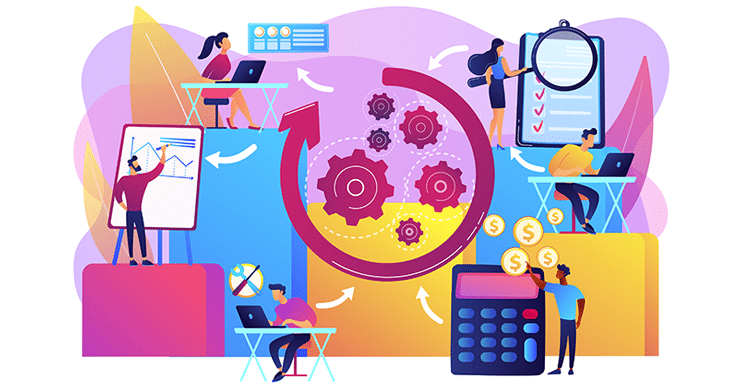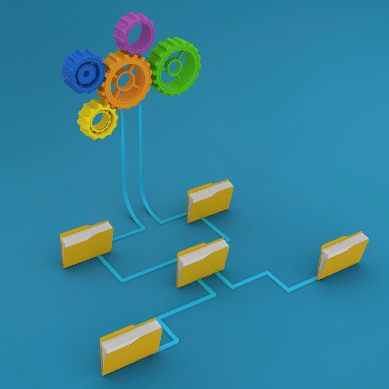What is Continuous Auditing?
With automated technologies readily available on the digital market, auditors can now analyze vast volumes of data in significantly shorter time frames, giving rise to continuous auditing. Unlike traditional point-in-time audits, continuous auditing emphasizes ongoing evaluations of practices, risk controls, compliance measures, IT systems, and business processes. Enabled by readily available data and automation-driven audit procedures, continuous auditing encompasses the following key components:
- Continuous Risk, Control, and Process Monitoring
Automation empowers auditors to consistently monitor a company’s IT systems, transactions, and controls. In addition, it enables swift identification of potential risks, control failures, and transaction errors in almost real-time.
- Investigation of Potential Inappropriate Activities
Continuous auditing facilitates the prompt detection of anomalies, inconsistencies, and outliers, bridging the gap between issue identification and resolution.
- Continuous Reporting to Stakeholders
Iterative reporting ensures stakeholders are informed about the organization’s risk and control status throughout the financial year.
Continuous auditing and monitoring marks a shift in the way auditors work. The evolution from traditional periodic audits to ongoing, real-time evaluations empowers auditors to make timely decisions. Automation is pivotal in collecting audit evidence and indicators from various systems. Continuous auditing often acts as an early warning system, detecting control failures and new issues more promptly than traditional methods.

Continuous Auditing Implementation Strategies
Implementing continuous auditing requires a well-defined plan and approach. Consider the following steps to get started:
Establish Priority Areas:
- Identify critical business processes aligning with top risks, regulatory mandates, and organizational goals.
- Cross-reference these processes with your organization’s risk assessment to ensure they address vital vulnerabilities.
- Prioritize processes significantly impacting financial reporting, regulatory compliance, operational efficiency, and strategic objectives.
Identify Audit Rules:
- Conduct a thorough risk assessment for the identified priority areas. This involves evaluating internal and external information sources to determine potential risks and control weaknesses.
- Collaborate with relevant stakeholders to gather insights into the inherent risks within these processes.
- Develop audit rules that are aligned with the identified risks. These rules are specific criteria or indicators that will be used to detect anomalies, inconsistencies, or deviations from expected norms.
Determine Process Frequency:
- Evaluate the balance between cost, benefit, and risk when determining the frequency of continuous auditing activities.
- Consider the nature of the process, the likelihood of changes, the level of inherent risk, and the impact on financial statements or operational efficiency.
- High-risk processes may require frequent monitoring, while lower-risk areas may be monitored less frequently to optimize resources.
Designate Roles
- Assign responsibility to individuals or teams for reviewing the exceptions and findings generated by the continuous auditing process.
Configure Parameters and Execute:
- Develop testing scripts that incorporate the audit rules you’ve established. These scripts will extract, analyze, and evaluate relevant data from the systems.
- Execute the testing scripts to collect data and perform automated analyses based on the defined parameters.
Manage Results and Follow-Up:
- Evaluate the results to determine the significance of each exception and whether it indicates a genuine issue or a false positive.
- Make informed decisions based on the findings, such as initiating further investigations, recommending process improvements, or escalating issues to higher management.
Report Results:
- Prepare formal reports that provide insights into the results’ risks, control weaknesses, and consequences.
- Communicate findings clearly and concisely to management, highlighting the potential impact on financial reporting, compliance, and operational efficiency.
- Offer recommendations for addressing the identified issues and improving the control environment.
Assess Emerging Risks and Add to Register:
- Integrate the results of continuous auditing into the organization’s risk assessment process.
- Use the insights gained from continuous auditing to identify emerging risks and update the risk register accordingly.
Start Getting Value With
Centraleyes for Free
See for yourself how the Centraleyes platform exceeds anything an old GRC
system does and eliminates the need for manual processes and spreadsheets
to give you immediate value and run a full risk assessment in less than 30 days
Are There Risks Associated With Continuous Auditing?
While the benefits of continuous auditing are apparent, it’s important to acknowledge potential risks and challenges associated with any audit process. Some of the risks associated with constant auditing include:
Data Quality and Integrity:
- Continuous auditing relies heavily on accurate and reliable data. If the data used for monitoring and analysis is complete, accurate, and consistent, it can lead to false positives or negatives.
System Complexity:
- Continuous auditing may require integrating various systems, databases, and platforms. This complexity can lead to challenges in data extraction accuracy. In general, continuous auditing is possible in mature organizational systems. If the underlying data infrastructure and internal controls are inaccurate or incomplete, it can compromise the reliability of the results.
Resource Intensiveness:
- Continuous auditing demands significant resources, including technology infrastructure, data analytics expertise, and personnel. Organizations must carefully consider the budgeting of these resources.
Centraleyes For Continuous Auditing
Continuous auditing is emerging as a transformative force in the audit domain, powered by cloud technologies and automation. This dynamic approach propels auditors into the realm of real-time assessments, revolutionizing the traditional audit timeline. Continuous auditing equips businesses with the tools to thrive in a rapidly evolving digital landscape by enabling early risk identification, improved control assurance, and enhanced reporting value.
The Centraleyes Risk and Compliance Management platform provides automated continuous auditing solutions for monitoring the audit process.
Periodically reassessing your controls can be crucial to the audit process. With Centraleyes, you can easily automate any assessment tasks and set up as many reassessment cadences as you’d like by simply setting dates in the frequency of your choice. The continuous auditing software will automatically send notifications to control owners when it is time to reassess their assigned tasks.
If you’d like to see the great value of our automated, continuous auditing firsthand, schedule a demo and experience the Centraleyes difference.
Start Getting Value With
Centraleyes for Free
See for yourself how the Centraleyes platform exceeds anything an old GRC
system does and eliminates the need for manual processes and spreadsheets
to give you immediate value and run a full risk assessment in less than 30 days





